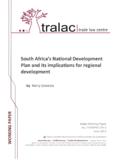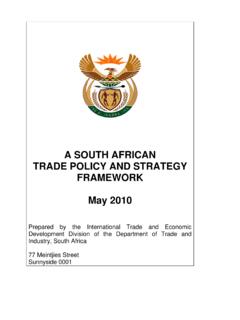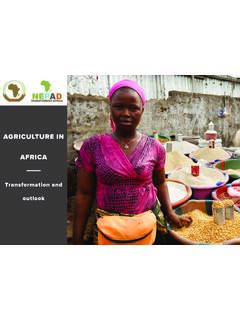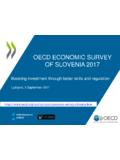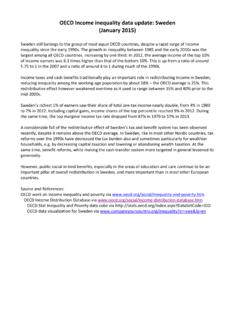Transcription of NATIONAL CO-OPERATIVE DEVELOPMENT POLICY …
1 THE REPUBLIC OF UGANDA NATIONAL CO-OPERATIVE DEVELOPMENT POLICY MINISTRY OF TOURISM, TRADE AND INDUSTRY BOX 7103 KAMPALA, UGANDA Website: February 2009 iiForeword . iiiTable of Contents Foreword .. ii ABBREVIATIONS AND ACRONYMS .. v 1 INTRODUCTION .. 1 Background .. 1 Rationale and Justification .. 2 Vision .. 3 Mission .. 3 Objectives .. 3 2 SITUATION ANALYSIS .. 5 Strengths .. 5 User Responsiveness .. 5 Income generation, distribution and redistribution .. 5 A Wide Network of Co-operatives and their Infrastructure.
2 6 Saving Culture within Co-operatives .. 6 Weaknesses .. 6 Leadership gaps .. 6 Inadequate knowledge on Co-operatives .. 6 Inadequate Human Resource .. 7 Dented Image and Weak Advocacy .. 7 Inadequate Formal CO-OPERATIVE Education .. 7 Insufficient financial Resources .. 8 Storage .. 8 Weak Management Information System .. 8 9 Political will .. 9 Labour Abundancy and Flexibility .. 9 Abundant natural resources .. 10 Existence of trained CO-OPERATIVE personnel within the community.
3 10 Literate Community .. 10 Existence of a Pool of Potential Cooperators within the Society .. 10 Wide scope of CO-OPERATIVE Enterprises .. 11 Strategic Location of Uganda as a Regional Hub for Trade .. 11 11 Inadequate Infrastructure .. 11 Entry of multinational corporations .. 12 Exploitative 13 HIV/AIDS and Malaria .. 13 Environmental Degradation .. 13 3 GUIDING PRINCIPLES .. 15 4 POLICY ACTIONS .. 16 Re-building the CO-OPERATIVE Movement .. 16 Legal and Regulatory Reforms.
4 16 Compliance .. 17 Quality Assurance and Competitiveness .. 17 Diversification of CO-OPERATIVE Enterprises .. 18 Human Resource DEVELOPMENT .. 18 Management Information System (MIS) .. 19 Crosscutting 19 Gender balance and fair representation of marginalized groups .. 19 Co-operatives and Sustainable Natural Resource Use .. 20 HIV/AIDS and Malaria .. 20 5 IMPLEMENTATION, INSTITUTIONAL FRAMEWORK AND MONITORING .. 21 Roles of key players .. 22 Ministry of Tourism Trade and Industry .. 22 District/Municipal Commercial/ CO-OPERATIVE Offices .. 23 Apex Body.
5 23 Tertiary CO-OPERATIVE Societies .. 24 Secondary CO-OPERATIVE Societies .. 24 Primary CO-OPERATIVE Societies .. 24 DEVELOPMENT Partners .. 25 6 CONCLUSION .. 26 vABBREVIATIONS AND ACRONYMS AGM: Annual General Meeting AIDS: Acquired Immune Deficiency Syndrome AMFIU: Association of Micro Finance Institutions of Uganda CICS: Competitiveness Investment Climate Strategy CIS: Community Information System COMESA: Common Market for Eastern and Southern Africa COPE Complementary Opportunity for Primary Education EAC East African Community FAL Functional Adult Literacy GDP: Gross Domestic Product HIV Human Immune Virus ICA: International CO-OPERATIVE Alliance ICT: Information Communication Technology IMF.
6 International Monetary Fund MDAs Ministries, Departments and Agencies MGLSD: Ministry of Gender, Labour and Social DEVELOPMENT MTTI: Ministry of Tourism, Trade and Industry NAADS: NATIONAL Agricultural Advisory Services NGC: New Generation Co-operatives NGO: Non-Governmental Organization NRM: NATIONAL Resistance Movement PEAP: Poverty Eradication Action Plan PMA: Plan for Modernization of Agriculture R&D: Research and DEVELOPMENT . RDS: Rural DEVELOPMENT Strategy SACCOS: Savings and Credit CO-OPERATIVE Societies UCA: Uganda CO-OPERATIVE Alliance Ltd. UCSCU: Uganda CO-OPERATIVE Savings and Credit Union UPE Universal Primary Education USE Universal Secondary Education WTO World Trade Organisation 11 INTRODUCTION Background The CO-OPERATIVE movement is a global institution, comprising of over 800 million people, that is found in almost every country in the world.
7 A CO-OPERATIVE is defined as An association of persons united voluntarily to meet their common economic, social, and cultural needs and aspirations through a jointly owned and democratically controlled enterprise .1 Co-operatives worldwide are based on the principles of voluntary and open membership, democratic member control, member economic participation, autonomy and independence, education, training and information, co-operation among co-operatives and concern for the community. In Uganda co-operatives are organized in a four tier vertical structure of primary societies that consist of at least 30 persons aged above 12 years. A minimum of two primary societies form a secondary while two or more secondary societies form a tertiary which provides specialized services2.
8 Secondary and tertiary societies form the apex. Ugandans started organizing themselves into co-operatives in 1913. Co-operatives operated informally until 1946 when the first CO-OPERATIVE ordinance was enacted. This marked the birth of the CO-OPERATIVE department and the present CO-OPERATIVE movement and by the end of 1946 there were 75 organizations of a cooperatve nature. Fifty (50) of these were agriculture marketing societies, 8 were shop keepers (supply) societies, 6 were consumer stores and the remainder were miscellaneous societies such as fishermen (mainly for supply of nets), cattle and dairy societies and one thrift society.
9 3 The period 1946 to 1970 saw a significant growth of the CO-OPERATIVE movement especially in the cotton and coffee sectors. In 1951, co-operatives handled 14,300 tons of cotton and coffee. Following the acquisition of two coffee curing works and ten ginneries 1 International CO-OPERATIVE Alliance (2008) Statement on CO-OPERATIVE Identity. They include financial, insurance, transport, housing among others 3 Shafiq Arain (1967) The Report of the Committee of Inquiry into the Affairs of all CO-OPERATIVE Unions in Uganda. 2in 1956, the total tonnage rose to 89,308 tons by 1960. In 1965, out of 437,923 bales of cotton produced in the country, co-operatives handled 267,420 bales (61%) while they also handled 40% of the Robusta coffee; valued at 60 million shillings and 90% of Arabic coffee valued at 30 million shillings.
10 Beginning with the 1970s, the co-operatives were greatly mismanaged, interfered with, and alienated from membership. The CO-OPERATIVE movement was misunderstood and its economic and social impact greatly underrated by both the membership and public. This marked the beginning of a steady decline in the performance of co-operatives. The period 1992 through 2006 exhibited a continuous decline of the CO-OPERATIVE movement participation in the economy, for instance, of the total coffee exports (130,068 tons) in 1992/93, co-operatives accounted for 22 %( 28,585 tons). The percentage dropped to only 2 (3,868 tons) out of the total of 180,164 tons in 2001/02 and further to a meager 1 (2,104 tons) out of 162,254 tons in 2006/07.
